Physical Address
304 North Cardinal St.
Dorchester Center, MA 02124
The concept of “malignant fibrous histiocytoma” (MFH) has undergone significant change over six decades, and this term has been supplanted or replaced by undifferentiated pleomorphic sarcoma . The term was introduced in 1963 to refer to a group of soft tissue tumors characterized by a storiform or cartwheel-like growth pattern. They were believed to be derived from histiocytes on the basis of early tissue culture studies that demonstrated ameboid movement and phagocytosis of explanted tumor cells. Ultrastructural studies both endorsed and refuted the histiocytic origin of these tumors. Immunohistochemistry (IHC) showed that the phenotype of this tumor was more closely aligned with a fibroblast than a histiocyte. Furthermore, many (but not all) lesions labeled as malignant fibrous histiocytoma could, on scrutiny, be subclassified as “lineage-specific sarcomas,” an observation that questioned the existence of MFH as a distinct entity. The extent to which such lesions can be subclassified as sarcomas of a specific type largely depends on definitional criteria and the number of ancillary studies a pathologist is willing to use in evaluating a pleomorphic sarcoma. There is still no general agreement on what percentage of pleomorphic sarcomas, when subjected to rigorous evaluation, remain unclassified, with reports ranging from 20% to 70%. In a Swedish Sarcoma Group study of 338 cases referred centrally with MFH, the diagnosis was confirmed in 70% after reevaluation and additional IHC. These discrepancies underscore that the criteria by which a pleomorphic tumor is provisionally labeled as an “undifferentiated pleomorphic sarcoma” (UPS), as well as the criteria by which some are reclassified, differ from institution to institution.
Whatever the true incidence of this lesion, it is agreed that the term MFH should be supplanted by UPS . By combined sampling and IHC, the tumor shows no definable line of differentiation. However, by electron microscopy, it manifests fibroblastic/myofibroblastic features. As increasingly more advanced technologies are used in the evaluation of pleomorphic sarcomas, this definition may well change. Molecular studies have suggested that most, if not all, “retroperitoneal malignant fibrous histiocytomas” of the storiform and inflammatory type are actually dedifferentiated liposarcomas.
At this point, the term undifferentiated pleomorphic sarcoma (UPS) is used in diagnostic reports but is understood to be synonymous with “malignant fibrous histiocytoma” (MFH), which may be provided in parentheses to avoid any misunderstanding with clinicians who continue to be familiar with that term.
Virtually any type of pleomorphic sarcoma may have areas that resemble UPS. In some cases, determining the specific line of differentiation may rely on random sampling of a small area within a large tumor. Although a specific type of pleomorphic sarcoma may be suggested by histologic features, immunohistochemical stains are often required to confirm the diagnosis. Although it could be argued that subtyping pleomorphic sarcomas is nothing more than an academic exercise, some evidence suggests that pleomorphic sarcomas with myogenic differentiation are more clinically aggressive than those without myogenic differentiation.
The only criterion for rendering a diagnosis of pleomorphic liposarcoma is the recognition of multivacuolated pleomorphic lipoblasts. The major difficulty in such cases is separating pleomorphic sarcomas that infiltrate and isolate individual fat cells from those with true lipoblasts. Pleomorphic leiomyosarcoma is composed of cells with distinct cytoplasmic eosinophilia. At least focally, most cases have areas with a fascicular arrangement, along with cells with blunt-ended nuclei, a perinuclear vacuole, and deeply eosinophilic cytoplasm. Pleomorphic rhabdomyosarcoma is recognized by the presence of large cells with eosinophilic cytoplasm and cross-striations; its phenotype can be confirmed by the immunohistochemical demonstration of skeletal muscle differentiation (desmin, MyoD1, myogenin). A definitive diagnosis of pleomorphic malignant peripheral nerve sheath tumor can be exceedingly difficult unless the pleomorphic sarcoma clearly arises from a benign nerve sheath tumor, or arises from a peripheral nerve in a patient with type 1 neurofibromatosis. The only criterion for recognizing extraskeletal osteosarcoma is the production of osteoid or bone by cytologically malignant cells.
The process of tumor progression or dedifferentiation involves the transformation of a low-grade sarcoma to a higher-grade sarcoma, which usually (but not always) resembles a UPS. The most common scenario is the progression of a low-grade, well-differentiated liposarcoma (also known as atypical lipomatous tumor ) to a pleomorphic sarcoma ( dedifferentiated liposarcoma ). Other low-grade neoplasms can also dedifferentiate, including chondrosarcomas, chordomas, and parosteal osteosarcomas. In a limited biopsy specimen, it can be impossible to prove that a pleomorphic sarcoma is part of a dedifferentiated sarcoma if the low-grade component is not represented. However, in a retroperitoneal sarcoma, where dedifferentiated liposarcoma is always a strong consideration, often the suggestion is that the high-grade sarcoma could be part of a dedifferentiated liposarcoma. Unfortunately, even MDM2 or CDK4 amplification does not unequivocally prove that a given lesion is part of a dedifferentiated liposarcoma, since other pleomorphic sarcomas (e.g., leiomyosarcoma) can show amplification of these genes. The clinical significance of distinguishing a dedifferentiated liposarcoma from a de novo pleomorphic sarcoma is not clear, but some have suggested that the former is a more indolent tumor than the latter. A newer, epidemiological study by Corey et al. supports the idea that dedifferentiated liposarcoma fares better in 2- and 5-year survival compared to “sarcoma, NOS.”
It can be exceedingly difficult to distinguish a UPS from a sarcomatoid carcinoma . A reasonable approach would be to assume that a pleomorphic malignant neoplasm arising in the skin, mucosal surface, or parenchymal organ is a sarcomatoid carcinoma, until proven otherwise. A battery of epithelial markers, including broad-spectrum, low- and high-molecular-weight keratins is required, but equivocal results can occur for several reasons. First, not all sarcomatoid carcinomas show the immunohistochemical expression of epithelial markers. Second, virtually any type of sarcoma, including UPS, can occasionally express keratins. Strong and diffuse keratin expression, especially with multiple antibodies, strongly supports a diagnosis of sarcomatoid carcinoma, as does the recognition of an intraepithelial/intramucosal, dysplastic component. In the end, some cases are not resolvable and can be diagnosed as only a pleomorphic malignant neoplasm, sarcoma versus carcinoma. On occasion, sarcomatoid mesothelioma , melanoma, and anaplastic lymphoma also can mimic UPS; a panel of markers, including keratins, p63, p40, S-100 protein, melanocytic markers (e.g., HMB-45, melan-A), CD30, and ALK1, can help resolve these issues. Following the exclusion of the aforementioned scenarios, one is left with UPS as a diagnosis of exclusion, the details of which are described in the following sections.
Atypical fibroxanthoma (AFX) typically occurs on sun-damaged, actinic skin of elderly persons. Its superficial location has generally been credited with its excellent clinical outcome. The diagnosis of AFX needs to be strictly defined so that it does not include other pleomorphic tumors of the skin (e.g., melanoma) or deeply invasive sarcomas that are well known to have metastatic potential. The term “superficial” MFH is discouraged because it may suggest a more aggressive tumor and result in overly aggressive treatment. The distinction of this lesion from what is now referred to as pleomorphic dermal sarcoma is discussed later.
This tumor typically occurs on the exposed surface of the head and neck, particularly the nose, cheek, and ear, of elderly individuals. In the large study by Beer et al. of 171 cases, only 9% of lesions occurred on the extremities or trunk. The majority of patients are elderly men, with a peak incidence in the seventh decade of life. Those rare tumors reported to occur on the extremities of young individuals are likely examples of atypical fibrous histiocytomas (see Chapter 10 ). Most lesions appear as exophytic, dome-shaped nodules, which may be described as rapidly growing. It usually measures between 1 and 2 cm at the time of excision. Solar and therapeutic radiation are strong predisposing factors in the pathogenesis of this disease. This is supported by the common occurrence of the tumor on sun-damaged skin, its frequent association with other actinic lesions (e.g., basal cell carcinoma, squamous carcinoma), and the identification of both ultraviolet (UV)-related mutations and photoproducts within these lesions. In most patients the latent period between radiation exposure and appearance of the AFX is more than 10 years and therefore well in keeping with the accepted interval for a radiation-induced tumor. Some cases arise in immunosuppressed patients; this tumor has been reported in HIV-positive patients and transplant patients taking immunosuppressive agents. AFX also has been reported to arise in patients with xeroderma pigmentosa.
Grossly, the lesions are solitary nodules or ulcers usually measuring less than 2 cm in diameter ( Figs. 12.1 and 12.2 ). Their appearance is not distinctive. For this reason, a variety of preoperative diagnoses may be considered, including basal cell carcinoma, squamous cell carcinoma, pyogenic granuloma, and sebaceous cyst.
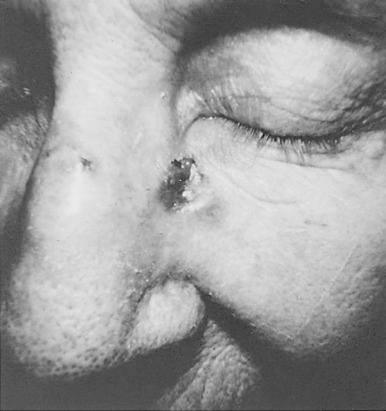
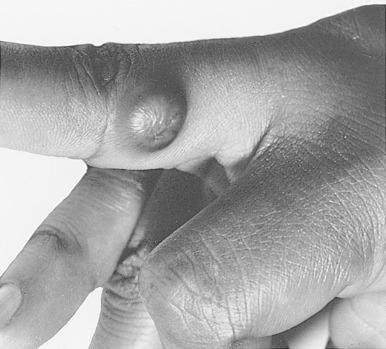
These tumors are expansile dermal nodules that abut the epidermis, causing pressure atrophy or ulceration ( Fig. 12.3 ). Alternatively, a grenz zone of uninvolved dermis may be present. The tumor compresses the skin appendages laterally and extends into the subcutis. By definition, the tumor does not extensively involve the subcutis, and it does not invade deeper structures such as fascia or muscle. Areas adjacent to these lesions typically display solar elastosis, vascular dilation, and capillary proliferation.
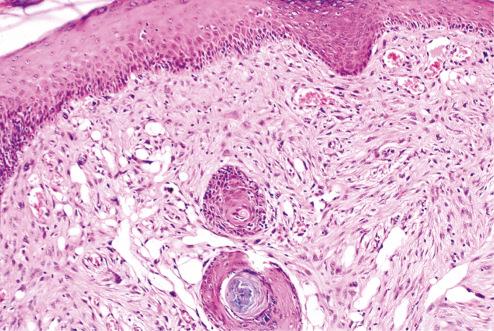
Histologically, these tumors resemble UPS, although some can have a more monomorphic fascicular appearance resembling a fibrosarcoma (so-called spindle cell variant of AFX). Most are characterized by bizarre cells arranged in a haphazard or vaguely fascicular pattern ( Fig. 12.4 ), but a storiform pattern may be evident. The cells are spindle shaped or round and exhibit multinucleation, pleomorphism, and numerous typical and atypical mitotic figures. The cells occasionally have small droplets of neutral fat and periodic acid–Schiff (PAS)–positive, diastase-resistant material, two features that probably reflect, in part, degenerative changes. Hemorrhage is occasionally prominent and may lead to extensive hemosiderin deposits that should be distinguished from melanin (pigmented AFX). Secondary changes include chronic inflammatory cells, prominent stromal myxoid change, osteoclast-like giant cells, osteoid deposition, prominent clear cells, or granular cell change ( Fig. 12.5 ). Keloidal collagen may be present, and some cases show extensive stromal hyalinization, suggesting tumor regression. Despite the worrisome morphologic features, AFX lacks tumor necrosis, perineural invasion, or lymphovascular invasion.
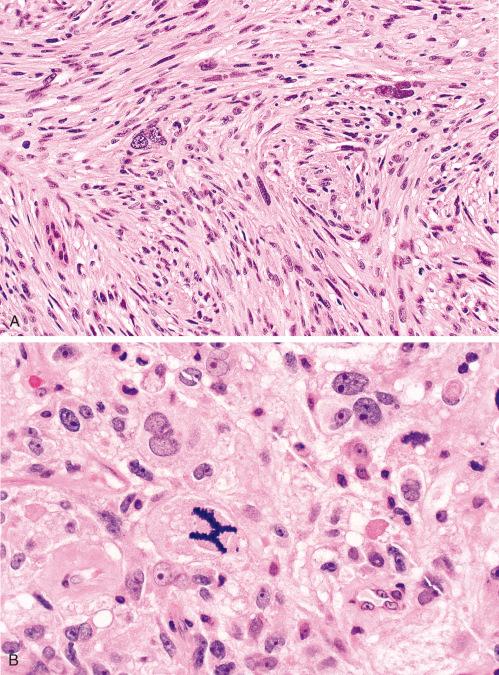
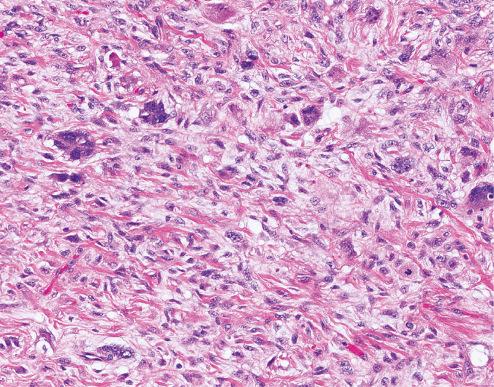
Immunohistochemically, AFX is typically negative for S-100 protein, SOX10, and keratins, allowing distinction from melanoma and spindled squamous cell carcinoma (SCC). However, rare cases can show scattered keratin-positive cells, although they are usually negative for high-molecular-weight keratins (e.g., CK5/6) and p63/p40, markers that are frequently expressed in spindled SCC. Most cases of AFX also show strong expression of CD10, but this marker lacks specificity; most cases of benign fibrous histiocytoma also express this antigen, as do rare cases of spindled SCC. Some cases express smooth muscle actin (SMA), although desmin is consistently negative, consistent with focal myofibroblastic differentiation. Other markers that are typically negative include CD34, ERG, h-caldesmon, HMB-45, and melan-A, although some cases do stain for MiTF.
As with other UV-induced tumors, AFX shows a high frequency of TP53 mutations with abnormal accumulation of p53 on IHC in most cases. Interestingly, a study using CGH comparing AFX to UPS showed great genetic overlap, including −1q, −3p, −5q, −11p, −11q and +7q, +5p, +11q in both tumors. The most common findings were deletions of 9p and 13q, both found in 58% of AFX cases. However, UPS had additional losses/gains that were not found in AFX. Sakamoto et al. found mutations in HRAS and KRAS in UPS, but not in AFX. More recently, Griewank et al. detected recurrent mutations in FAT1 , NOTCH1/2 , CDKN2A , TP53, and the TERT promoter in both AFX and pleomorphic dermal sarcomas, suggesting these entities are genetically related and possibly represent ends of a common spectrum (see later). RAS mutations were found only in pleomorphic dermal sarcomas and were absent in AFX.
Become a Clinical Tree membership for Full access and enjoy Unlimited articles
If you are a member. Log in here